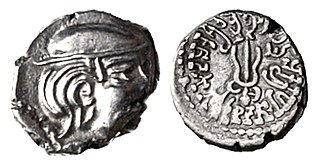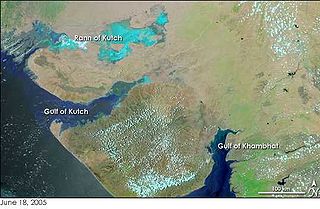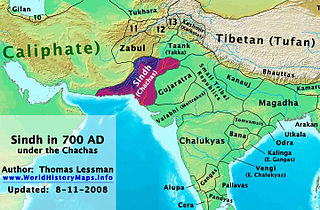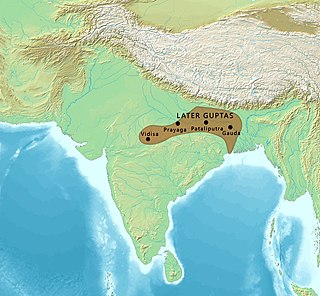Related Research Articles

Naval warfare is combat in and on the sea, the ocean, or any other battlespace involving a major body of water such as a large lake or wide river. Mankind has fought battles on the sea for more than 3,000 years. Even in the interior of large landmasses, transportation before the advent of extensive railroads was largely dependent upon rivers, canals, and other navigable waterways.

The Middle kingdoms of India were the political entities in India from 200 BCE to 1200 CE. The period begins after the decline of the Maurya Empire and the corresponding rise of the Satavahana dynasty, starting with Simuka, from 230 BCE. The "Middle" period lasted for about 1,500 years and ended in 1200 CE, with the rise of the Delhi Sultanate, founded in 1206, and the end of the Later Cholas.
This is a timeline of Indian history, comprising important legal and territorial changes and political events in India and its predecessor states. To read about the background to these events, see History of India. See also the list of governors-general of India, list of prime ministers of India and Years in India.

The history of southern India covers a span of over four thousand years during which the region saw the rise and fall of a number of dynasties and empires. The period of known history of the region begins with the Iron Age period until the 15th century CE. Dynasties of Chera, Chola, Pandyan, Travancore, Cochin, Zamorin, Kolathunadu, Chalukya, Pallava, Satavahana Rashtrakuta, Kakatiya, Reddy dynasty, Seuna (Yadava) dynasty and Hoysala were at their peak during various periods of history. These Dynasties constantly fought amongst each other and against external forces when northern armies invaded southern India. Vijayanagara empire rose in response to the Muslim intervention and covered the most of southern India and acted as a bulwark against Mughal expansion into the south. When the European powers arrived during the 16th and 18th century CE, the southern kingdoms, most notably Tipu Sultan's Kingdom of Mysore, resisted the new threats, and many parts eventually succumbed to British occupation. The British created the Madras Presidency which acted as an administrative centre for the rest of South India, with them being princely states. After Indian independence South India was linguistically divided into the states of Andhra Pradesh, Tamil Nadu, Karnataka, Telangana and Kerala.

The Gurjara-Pratihara dynasty was an imperial power during the Late Classical period on the Indian subcontinent, that ruled much of Northern India from the mid-8th to the 11th century. They ruled first at Ujjain and later at Kannauj.

The Pandya dynasty, also referred to as the Pandyas of Madurai, was an ancient dynasty of South India, and among the three great kingdoms of Tamilakam, the other two being the Cholas and the Cheras. Extant since at least the 4th to 3rd centuries BCE, the dynasty passed through two periods of imperial dominance, the 6th to 10th centuries CE, and under the 'Later Pandyas'. The Pandyas ruled extensive territories, at times including regions of present-day South India and northern Sri Lanka through vassal states subject to Madurai.

Rajaraja I born Arulmoli Varman often described as Rajaraja the Great was a Chola emperor who reigned from 985 CE to 1014 CE and was the most powerful king in south at his time chiefly remembered for reinstating the Chola power and ensuring its supremacy in South India and Indian Ocean.

The Maitraka dynasty ruled western India from approximately 475 to approximately 776 CE from their capital at Vallabhi. With the sole exception of Dharapatta, who followed the Mithraic mysteries, they were followers of Shaivism. Their origin is uncertain but they were probably Chandravanshi Kshatriyas.
Dantidurga, also known as Dantivarman II was the founder of the Rashtrakuta Empire of Manyakheta. His capital was based in Gulbarga region of Karnataka. His successor was his uncle Krishna I who extended his kingdom to all of Karnataka.
Nagabhata II was an Indian Emperor from Pratihara Dynasty. He ascended the throne of Pratihara Empire after his father Vatsraja. His mother was queen Sundari-Devi. He was designated with imperial titles - Paramabhattaraka, Maharajadhiraja, and Paramesvara after conquest of Kannauj.

Indian maritime history begins during the 3rd millennium BCE when inhabitants of the Indus Valley initiated maritime trading contact with Mesopotamia. As per Vedic records, Indian traders and merchants traded with the far east and Arabia. During the Maurya period, there was a definite "naval department" to supervise the ships and trade. At the end of 1st century BCE Indian products reached the Romans during the rule of Augustus, and the Roman historian Strabo mentions an increase in Roman trade with India following the Roman annexation of Egypt. As trade between India and the Greco-Roman world increased, spices became the main import from India to the Western world, bypassing silk and other commodities. Indians were present in Alexandria while Christian and Jewish settlers from Rome continued to live in India long after the fall of the Roman Empire, which resulted in Rome's loss of the Red Sea ports, previously used to secure trade with India by the Greco-Roman world since the Ptolemaic dynasty. The Indian commercial connection with Southeast Asia proved vital to the merchants of Arabia and Persia during the 7th–8th century. A study published in 2013 found that some 11 percent of Australian Aboriginal DNA is of Indian origin and suggests these immigrants arrived about 4,000 years ago, possibly at the same time dingoes first arrived in Australia.

Ezhimala, a hill reaching a height of 286 metres (938 ft), is located near Payyanur, in Kannur district of Kerala, south India. It is a part of a conspicuous and isolated cluster of hills, forming a promontory, 38 km (24 mi) north of Kannur (Cannanore). The Indian Naval Academy at Ezhimala is the Asia's largest, and the world's third-largest, naval academy.

Bappa Rawal, also known as Kalbhoj was a ruler and founder of the Mewar (Medapata) region in Rajasthan, India. The bardic chronicles describe him as a member of the Guhila Rajput Clan, and some of these consider him as the founder of the Guhila dynasty. Different historians have identified him with various rulers of the Guhila dynasty, including Kalabhoja, Shiladitya, and Khumana.
Nagabhata I was a king who founded the imperial Gurjara Pratihara dynasty of northern India. He ruled the Avanti region in present-day Madhya Pradesh, from his capital at Ujjain. He may have extended his control over the Gurjara country, which includes parts of present-day Gujarat and Rajasthan. He repulsed an Arab invasion from Sindh, probably led by Junayd ibn Abd al-Rahman al-Murri or Al Hakam ibn Awana.

In the first half of the 8th century CE, a series of battles took place between the Umayyad Caliphate and kingdoms to the east of the Indus river, in present-day India

The Chola Navy comprised the naval forces of the Chola Empire, a Tamil thalassocratic empire of southern India, one of the longest-ruling dynasties in the world. The Chola Navy grew in size and status during the Medieval Cholas reign. Between 900 and 1100 CE, the navy grew from a smaller entity to a potent maritime and diplomatic force across Asia, with maritime trade links extending from Arabia to China.
Gurjaradesa or Gurjaratra,is a historical region in India comprising the eastern Rajasthan and northern Gujarat during the period of 6th -12th century CE. Gurjara, in history was applicable to a region in the middle of 6th century with its capital at Bhinmalla, having its southern boundary around Saraswati river and northern boundary beyond current city of Jodhpur. Its citizens when migrated to other parts of the country, were known as Gurjaras from the name of their homeland. Rulers of this region consolidated surrounding parts of homogenous people, thus Gurjardesa became co-terminous with the kingdom of its Kings. Over years, the homogenous people of this region expanded the boundary of Gurjardesa under their kings and established a mighty empire. Over a period, these rulers shifted their capital from Bhinmalla to Jalore, Jalore to Ujjayani and Ujjayani to Kannauj. These rulers who are styled as Pratihars of Kannauj or Gurjara-Pratihara by the historians, looked to Gurjardesa as their homeland and thus called Gurjaras. Modern day state of Gujarat is different that Gurjardesa, historically and geographically and it is not the same as Gurjardesa.

The Later Gupta dynasty ruled the Magadha region in eastern India between the 6th and 8th centuries CE. The Later Guptas succeeded the imperial Guptas as the rulers of Magadha, but there is no evidence connecting the two dynasties; these appear to be two distinct families. The Later Guptas are so-called because the names of their rulers ended with the suffix "-gupta", which they might have adopted to portray themselves as the legitimate successors of the imperial Guptas.

The Saindhavas, also known as Jayadrathas, was a Medieval Indian dynasty that ruled western Saurashtra from c. 735 CE to c. 920 CE, probably in alliance with Maitrakas in its early years. Their capital was at Bhutamabilika. The known historical events during their rule are the attacks of Arabs repulsed by Agguka I.
Tamil Dynasties are the kingdoms who ruled over present day Tamil Nadu and Kerala. These include the Pallavas, the Pandyas, the Cholas and the Cheras.
References
- ↑ Dilip K. Chakrabarty (2010). The Geopolitical Orbits of Ancient India: The Geographical Frames of the Ancient Indian Dynasties. Oxford University Press. ISBN 9780199088324.
- ↑ John Middleton (2015). World Monarchies and Dynasties. Routledge. p. 489. ISBN 9781317451587.
- ↑ Kumar, Amit (2012). "Maritime History of India: An Overview". Maritime Affairs:Journal of the National Maritime Foundation of India. Taylor & Francis. 8 (1): 93–115. doi:10.1080/09733159.2012.690562. S2CID 108648910.
In 776 AD, Arabs tried to invade Sind again but were defeated by the Saindhava naval fleet. A Saindhava inscription provides information about these naval actions.
- ↑ Sailendra Nath Sen (1 January 1999). Ancient Indian History and Civilization. New Age International. pp. 343–344. ISBN 978-81-224-1198-0.